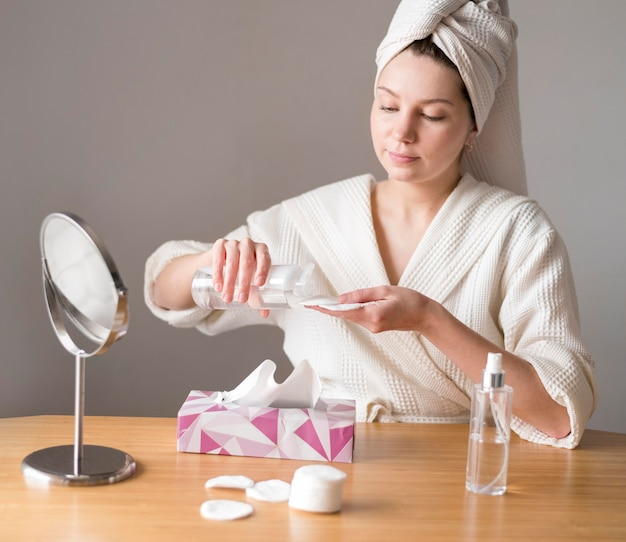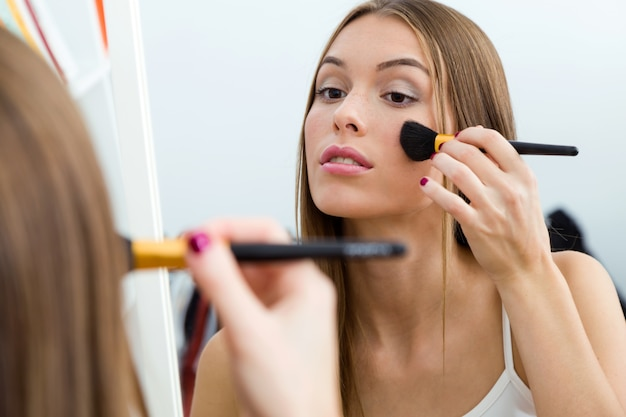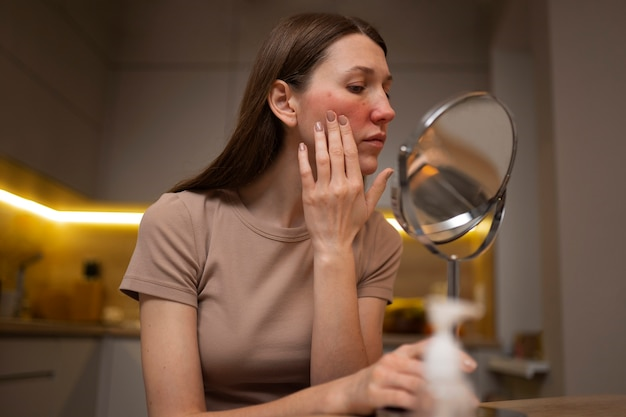The Art of Cleansing: Finding the Perfect Cleanser for Your Skin
In the world of skincare, the art of cleansing stands as the foundational cornerstone. It’s the canvas upon which we begin our daily rituals, the essential step that sets the stage for the rest of our skincare routine. The quest to discover the perfect cleanser, one tailored to our unique skin type and needs, is akin to an artist seeking the ideal palette of colors. It’s an art, a science, and a personal journey all rolled into one.

In this exploration, we delve deep into the world of skincare, where we’ll uncover the intricacies of skin cleanser types, the importance of choosing the right facial cleanser, and the rituals that constitute an effective cleansing routine. Along the way, we’ll also unravel the secrets of cleanser ingredients, from natural options for sensitive skin to the benefits of double cleansing. We’ll explore the significance of pH levels, the techniques that promote glowing skin, and even alternative methods like the oil cleansing method. So, come with us on this artistic journey of cleansing, where the canvas is your skin, and the masterpiece is the healthy, radiant complexion you’ll unveil.
Skin Cleanser Types
When embarking on the quest to find your ideal cleanser, you’ll encounter a diverse range of skin cleanser types. Each type caters to different skin needs and preferences. Let’s explore some common options:
Gel Cleansers
Gel cleansers are known for their ability to remove excess oil and impurities, making them a top choice for those with oily or combination skin. They offer a refreshing cleanse without over-drying.
Cream Cleansers
Ideal for individuals with dry or sensitive skin, cream cleansers provide a gentle and hydrating cleanse. They often contain moisturizing ingredients to soothe the skin.
Foam Cleansers
Foam cleansers create a light and airy lather, deeply cleansing the skin and removing makeup. They are suitable for normal to oily skin types.
Micellar Water
Micellar water is a gentle, no-rinse cleanser that effectively removes makeup and impurities. It’s an excellent choice for sensitive or dry skin.
Oil Cleansers
Oil cleansers work wonders in breaking down stubborn makeup and sunscreen. They are also favored for their ability to balance oily skin.
Choosing the Perfect Facial Cleanser
The journey to finding the perfect cleanser begins with choosing a facial cleanser that aligns with your skin’s specific needs and concerns. Here are some essential factors to consider:
- Know Your Skin Type
- Consider Skin Concerns
- Read Labels Carefully
- pH Matters
Cleansing Routine
A well-rounded cleansing routine sets the stage for healthy skin. It involves more than just cleansing; it’s a holistic approach to skincare. Here’s how to build a routine that works for you:
- Make cleansing a non-negotiable part of your morning and evening routines. Consistency helps maintain healthy skin.
- If you wear makeup, consider a pre-cleanse step. Micellar water or oil cleansers are excellent choices for removing makeup and sunscreen.
- While cleansing, take a moment to gently massage your face. This stimulates blood circulation and enhances the effectiveness of the cleanser.
- After cleansing, pat your face dry with a clean, soft towel. Avoid rubbing, as it can irritate the skin.
Best Cleanser for Clear Skin
For those seeking the best cleanser for clear skin, look for options that cater to your skin type and concerns:
- Salicylic Acid for Acne-Prone Skin
- Hydration for Radiance
- Gentle Exfoliation
Cleanser Ingredients
To truly master the art of cleansing, it’s crucial to understand the significance of cleanser ingredients:
- Aloe Vera
- Tea Tree Oil
- Chamomile
- Green Tea Extract
Natural Cleansers for Sensitive Skin
Sensitive skin requires gentle yet effective care. Embracing natural cleansers for sensitive skin is a wise choice to avoid harsh chemicals and irritants. Here are some natural ingredients to look for:
- Aloe Vera
- Chamomile
- Cucumber Extract
- Olive Oil
Benefits of Double Cleansing
The benefits of double cleansing go beyond the surface. This method involves using two different cleansers to thoroughly remove makeup, sunscreen, and impurities. Here’s how it works:
- Start with an oil-based cleanser to break down oil-based impurities such as makeup and sunscreen. Massage it into your skin to dissolve these products effectively.
- Follow up with a water-based cleanser to remove any remaining residue and cleanse your skin more deeply. This step ensures that your pores are clear and ready to absorb the goodness of your skincare products.
Hydrating Cleansers for Dry Skin
- Dry skin craves hydration, even during cleansing. Opt for hydrating cleansers for dry skin to maintain your skin’s moisture balance:
- Cream cleansers are rich and moisturizing, perfect for dry skin. They cleanse without stripping away essential oils, leaving your skin feeling soft and supple.
- Look for cleansers infused with hyaluronic acid, a powerhouse ingredient that attracts and retains moisture, ensuring your skin stays hydrated.
- Glycerin is a humectant that helps lock in moisture. Cleansers with glycerin can keep your skin’s hydration levels in check.
Acne-Prone Skin Cleansing Tips
Cleansing is a crucial step in the skincare routine of those with acne-prone skin. The right approach can help manage breakouts effectively:
- Salicylic Acid Cleansers
- Avoid Over-Cleansing
- Non-Comedogenic Products
Cleanser pH Levels and Skin Balance
The pH level of your cleanser can greatly impact your skin’s balance. Here’s what you need to know:
- Your skin has a natural pH level, typically slightly acidic. Cleansers with a pH level close to your skin’s natural balance help maintain its protective barrier.
- Avoid highly alkaline cleansers, as they can disrupt your skin’s pH balance, leading to dryness, sensitivity, and potential breakouts.
- Look for a cleanser with a pH level between 4.5 and 6.0 to ensure it’s gentle and won’t disturb your skin’s delicate equilibrium.
Cleansing Techniques for Glowing Skin
Glowing skin begins with effective cleansing techniques that clear away impurities and set the stage for further skincare. Here are some techniques to consider:
- Massage for Circulation
- Double Cleansing
- Steam and Warm Water
Oil Cleansing Method
The oil cleansing method is a transformative technique that can benefit many skin types, even those with oily skin. It involves using natural oils to cleanse your face. Here’s how it works:
- Select a suitable oil for your skin type. For example, those with dry skin may opt for olive or coconut oil, while jojoba oil is ideal for most skin types.
- Apply the oil to your dry face and gently massage it in, focusing on areas with makeup or impurities. The oil dissolves these substances effectively.
- Use a warm, damp cloth to steam your face, allowing the oil to penetrate your pores. Then, gently wipe away the oil and impurities. Follow with a water-based cleanser for a thorough cleanse.
Cleanser Application for Best Results
Proper cleanser application is key to reaping the full benefits of your chosen product. Here’s how to ensure you get the best results:
- Apply a pea-sized amount of cleanser to your fingertips. Using too much can lead to over-cleansing and strip your skin of its natural oils.
- Use lukewarm water for cleansing. Hot water can be harsh on the skin and may lead to dryness and irritation.
- After cleansing, pat your face dry with a clean, soft towel. Avoid rubbing, as it can damage your skin’s delicate surface.
Cleanser vs. Exfoliator
While both cleansers and exfoliators play essential roles in skincare, it’s crucial to understand the difference between them:
- Cleansers are formulated to remove makeup, sunscreen, and daily impurities from your skin. They clean the surface of your skin without exfoliating or removing dead skin cells.
- Exfoliators are designed to remove dead skin cells, revealing fresher, brighter skin beneath. They come in two types: physical (scrubs) and chemical (acids). Exfoliating should be done 2-3 times a week at most to avoid over-exfoliation.
Cleansing Steps for Healthy Skin
To maintain healthy, radiant skin, follow these essential cleansing steps as part of your daily skincare routine:
- Begin by removing makeup and sunscreen with an oil-based cleanser or micellar water. This ensures a clean canvas for your cleanser to work effectively.
- Apply your chosen cleanser using gentle, upward, circular motions. Massage for at least a minute to thoroughly remove impurities.
- Rinse your face with lukewarm water and pat it dry gently with a clean towel.
- Complete your routine with your preferred skincare products, such as toner, serum, moisturizer, and sunscreen (in the morning).
As we conclude our journey into “The Art of Cleansing: Finding the Perfect Cleanser for Your Skin,” we hope you’ve gained valuable insights into the world of skincare. Cleansing, as we’ve discovered, is far from a mundane task—it’s an art form, a science, and a daily ritual that connects us with our skin’s needs.
Remember that the perfect cleanser is one that caters to your skin’s unique characteristics and requirements. Whether you have clear skin, sensitive skin, or dry skin, there’s a cleanser out there waiting to become your skincare ally. Ingredients matter, too; choose wisely to nurture and protect your complexion.
Exploring techniques like double cleansing and embracing the right pH levels for your skin can make a world of difference. And don’t be afraid to venture into alternative methods like the oil cleansing method, which can work wonders for some skin types.
In the end, your cleansing routine is your canvas, and your skin is the masterpiece. Take the time to perfect your art of cleansing, and you’ll be rewarded with the glowing, healthy skin you deserve. So, go forth and cleanse wisely, knowing that each wash is a step closer to your skincare masterpiece.




